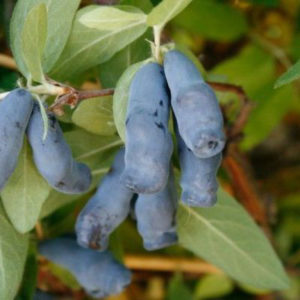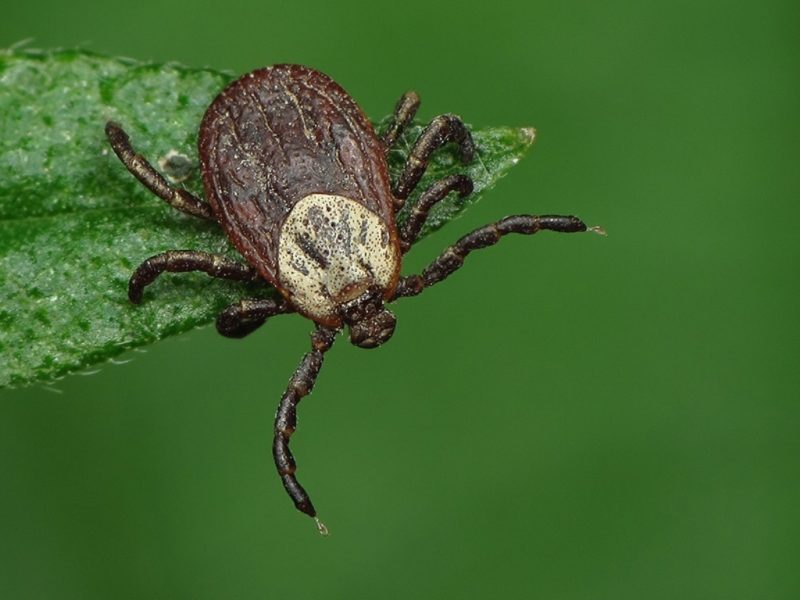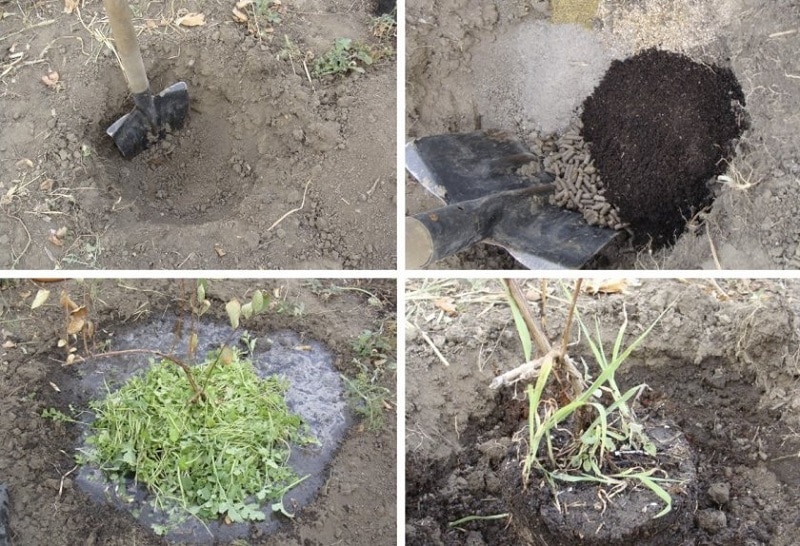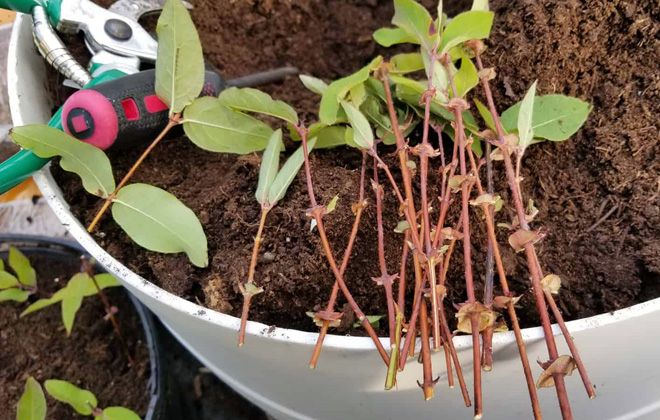Mid-season sweet honeysuckle variety Gzhelka
Gzhelka is a medium-ripening variety of edible honeysuckle with many advantages. Among them, frost resistance, dessert taste and weak fruit shedding are noted. Disadvantages include the need for proper watering and planting pollinator varieties nearby. In this article we will talk in detail about the advantages and disadvantages of Gzhelka honeysuckle, its requirements for planting and care.
Description of the honeysuckle variety Gzhelka
This is a domestic variety of edible honeysuckle, bred by a non-professional breeder.
The berries are characterized by a sweet, slightly sour taste and a rich chemical composition. They are useful to use to improve the functioning of the gastrointestinal tract, cardiovascular and nervous systems, strengthen the immune system and remove toxins.
Origin and development
Gzhelka honeysuckle was bred by L.P. Kuminov, an amateur breeder who for 30 years was creating new varieties based on Kamchatka and Magadan species.
The variety entered state variety testing in 1998. Included in the State Register of Agricultural Crops of the Russian Federation in 1998.
Characteristics, description of appearance, taste

The plant is a medium-sized (up to 2 m in height if grown in an open area), medium-spreading bush with pinkish-brown, erect, hairless shoots and rough brown-gray skeletal branches.
The leaves are bright green, finely hairy.During flowering, pink flowers appear in the leaf axils, arranged singly or in pairs.
The berries are slightly pubescent, pod-shaped with a slight crescent-shaped bend, large (2-2.5 cm long), weigh on average 1-1.2 g, covered with a thin dark blue skin with a bluish-silver waxy coating.
The pulp is light beige, juicy and aromatic, characterized by a sweet taste with a subtle sourness without bitterness.
Features of application
Gzhelka fruits are consumed fresh, frozen, and used for making juices, compotes, jam or wine.
Due to their decorative appearance, bushes are often used in landscape design, for example, to create hedges.
Ripening period, yield and fruiting
This is a medium ripening variety. Flowering begins in the 2-3rd decade of May, the harvest ripens at the end of June.
Productivity - 2.1-2.5 kg per bush. With proper care, the yield increases in the 3-4th year of the bushes’ life.
Resistance to diseases and pests
The variety is resistant to most fungal and viral diseases, but in case of heavy rains or excessive glaze it can be affected by powdery mildew.
Dangerous pests include aphids, mites, finger flies, leaf rollers and scale insects.

Resistance to cold and drought
Gzhelka is a frost-resistant honeysuckle. At rest, the bushes tolerate a drop in air temperature to -45...-47°C.
The plant is adversely affected by drought and excessive soil moisture. Drying out the soil and waterlogging of the soil can lead to the death of the bush.
Suitable regions
Due to its high degree of frost resistance, the variety is successfully cultivated in regions with temperate climates. In the southern regions, Gzhelka is not so comfortable.
Advantages and disadvantages
Among the main advantages of Gzhelka are:
- frost resistance;
- weak fruit shedding;
- pleasant sweet taste of berries without bitterness;
- large-fruited.
The disadvantages of the variety include:
- baking berries at high air temperatures when the bushes grow in an open area;
- poor tolerance to drought and heat;
- self-sterility.
Difference from other varieties and hybrids
A comparison of Gzhelka with other mid-season honeysuckle varieties is given in the table:
| Variety | Average weight of berries, g | Taste | Berry color | Productivity, kg/bush |
| Gzhelka | 1-1,2 | Sweet with subtle sourness | Dark blue | 2,1-2,5 |
| Berel | 0,85 | Sourish-sweet with tartness | Until 3 | |
| Cinderella | 0,7-1,4 | Sweet with sourness | Up to 0.8 | |
| Azure | 0,9-1,4 | Sweet and sour | Up to 2.3 | |
| Volkhova | 0,7 | Sweet with a delicate strawberry tint | Bright blue | 1,5-3 |
| Gerda | 0,7-0,9 | Sweet and sour | Blue | 1-1,6 |
| Kamchadalka | 1,2 | Sweet with sourness | Dark purple | Up to 1.5 |
| Fire opal | 1 | Sweet and sour | Blue-black | 3-5 |
Agricultural technology
Gzhelka is an unpretentious honeysuckle variety, but it still has certain planting and care requirements that must be met in order to get a high-quality harvest.
Choosing a place in the garden and preparing holes
To plant Gzhelka, choose a well-lit place, protected from the cold wind, located on a plain or hill.
It is advisable to create a little shade for the bushes, since the berries can bake in the open sun. The best option is the south side behind the building wall or close proximity to fruit trees.
The permissible groundwater level is about 1.5 m.
Preparing for landing
The selected area is first dug up and cleared of weeds and plant debris. If necessary, adjust the soil acidity level.So, before planting, acidic soil is limed or dolomite flour is added to it.
Soil requirements
Honeysuckle Gzhelka grows well in fertile, loose, light soil with sufficient moisture and breathability and a low or neutral degree of acidity. The most suitable option is loam.
Dates, scheme and rules of planting

Honeysuckle is planted on the site in the fall, 1.5-2 months before the onset of frost, or in the spring, before the buds appear. Due to early sap flow, spring planting of Gzhelka is unacceptable in regions with a temperate climate.
Planting pattern:
- In the prepared area, dig planting holes 40 cm deep and 50x50 cm in size. The optimal distance between bushes is 1.3 m, for mass planting - 1.8 m.
- Place a drainage layer of broken brick or expanded clay on the bottom.
- Mix the top layer with compost or peat, add superphosphate. Pour half of the resulting soil mixture into the hole.
- Place the seedling in the center of the hole, fill the voids with the remaining soil mixture so that the root collar is 4 cm above the soil level.
- Compact the soil, trim plant branches to 5 buds.
- Mulch the soil with humus or peat.
Features of cultivation
When watering, they are guided by weather conditions and the condition of the soil - it should not be allowed to dry out. During dry periods, honeysuckle is watered every 2-3 days, pouring 1-2 buckets of water under the bush.
They begin to feed Gzhelka 3 years after planting. Fertilizers are applied at the beginning of bud formation (urea, humus, rotted manure) and at the end of the season (complex mineral fertilizers, compost).
The main rules for pruning bushes:
- when planting a seedling, inspect its root system and remove all damaged parts, if any;
- Every spring, all damaged, dry, and old branches growing inside the bush are cut off from the bushes;
- pruning is not carried out if the air temperature is below 0°C or above +10…+12°C;
- Once every 6 years, the bushes are rejuvenated by cutting off all skeletal branches and perennial shoots.
During pruning, the tops of young shoots are preserved, since buds form there.
Pollinators
Gzhelka is a self-fertile variety of honeysuckle. To obtain a harvest, pollinating varieties are planted nearby - Gerda, A bunch of mala.
Reference. To attract insects that pollinate honeysuckle, the bushes are sprayed with syrup.
Disease and pest control
Diseases and pests, dangerous for Gzhelka honeysuckle are described in the table.
| Disease/pest | Treatment/prevention |
| Powdery mildew | Treatment of bushes with fungicidal preparations, for example, Topaz. |
| Leafrollers | To control pests, the drugs “Aktara”, “Fitoverm”, “Rogor”, “Aktellik” are used. For preventive purposes, bushes are treated with Bordeaux mixture. |
| Shields | |
| fingerwings | |
| Ticks | |
| Aphid |
Preparing for winter
Young plants need pre-winter preparation. At the end of autumn, the bushes are watered abundantly, hilled up, the trunk circle is mulched, the shoots are pulled together and secured with a rope, after which the crown is covered with burlap. In case of severe frosts, the bushes are additionally insulated with spruce branches.
Honeysuckle aged 4 years and older does not require crown cover. Preparation for winter for such bushes consists only of moisture-replenishing watering, fertilizing with organic fertilizers and mulching the tree trunk circle.
Reproduction

Gzhelka is propagated only vegetatively:
- Dividing the bush. An adult (over 5 years old) plant after the fruiting period is dug up and divided into several parts so that each has a healthy rhizome. The delenki are planted in a permanent place.
- By layering. The branch growing at the bottom of the bush is tilted to the ground, secured with a special bracket and sprinkled with soil. For the winter, the cuttings are covered, and in the spring they are separated from the mother bush and planted in a permanent place.
- By cuttings. After fruiting, annual shoots are cut into pieces. The resulting cuttings are placed in the ground, and when the next season begins and the air temperature becomes above zero, they are planted on the site.
During generative propagation, the plant loses its varietal characteristics.
Difficulties in growing
When growing Gzhelka, the following problems may arise:
- acidity or even bitterness in the taste of berries - the plants did not have enough moisture;
- lack of harvest - there are no pollinating varieties growing nearby on the site;
- a whitish coating on the bushes is a symptom of powdery mildew that has developed as a result of waterlogging of the soil.
Harvesting
The berries begin to be picked 7-10 days after they turn blue. In case of shedding, fabric or film is first spread under the bushes.
The collected fruits are placed in one layer in a shallow container. Honeysuckle is stored in the refrigerator for 2-3 days.
Tips and reviews from experienced gardeners
Experienced gardeners recommend:
- to attract more insects to pollinate honeysuckle, spray the bushes with syrup;
- treat plantings with Bordeaux mixture at the beginning and end of the season to prevent attacks pests.
They respond positively to this honeysuckle.
Vladislav, Gzhel: “When I was choosing a honeysuckle variety to grow on the site, I settled on Gzhelka - it was bred by my fellow countryman.I planted several bushes of the Kucha mala variety as pollinators. Gzhelka completely suits me - the berries are large, tasty, sweet. We eat them fresh, but the yield is quite high, so there is still some left over for jam.”
Ruslan, Moscow region: “I grow several types of honeysuckle of different ripening periods, one of them is Gzhelka. What I like about this variety is that it is easy to care for; the main thing is to monitor the frequency of watering so that the soil does not dry out, but also does not become waterlogged. The berries are very tasty and sweet. From one bush, 5 years after planting, I collect about 3 kg of harvest.”
Conclusion
Gzhelka is a mid-season honeysuckle variety, the main advantages of which include frost resistance, large fruit, dessert taste and the possibility of universal use of berries.
Among the disadvantages of the variety, there is a tendency to bake berries at high air temperatures, poor tolerance to drought and heat, as well as self-sterility.